
| Genus List | Species List | Genus Overview |
Identifying Azteca species from the morphological traits of individual workers is difficult. Colonies show strong size variation among workers (Wheeler 1986), and the size of the largest workers increases as colonies mature. The larger a worker is, the more queen-like it is and the more differentiable from other species. The following key is most likely to work when a series from a mature colony is available, so that the largest workers can be selected for examination. When size ranges are given in the key, they refer to these larger workers.
The workers of A. nanogyna and A. quadraticeps are unknown.
10b. Middle and hind tibia with distinct, pectinate apical spur; median lobe of clypeus not protruding, subparallel with lateral clypeal lobes (HLB/HLA less than 1.01); palpal formula 5,3 or 6,4: 30

20b. Dorsal surface of mandible striate; posterolateral margin of vertex subangular; sternal lobe of petiole longitudinally tectiform but not carinate: pilosula

30b. Outer surface of hind tibia with 5 or more erect setae (these may be very short, less than a quarter of tibial width, and difficult to see); palpal formula 5,3 or 6,4: 80

40b. Promesonotum less strongly produced, posterior mesonotum more shallowly sloping and meeting dorsal face of propodeum at more obtuse angle: 50

50b. Dorsal surface of mandible evenly covered with large setigerous puncta: 70
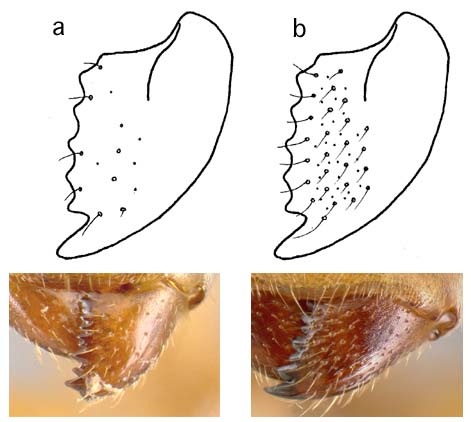
60b. Dorsum of mesosoma more "scruffy," with more setae, and these of irregular length (MNSC greater than 10, median about 20): ovaticeps
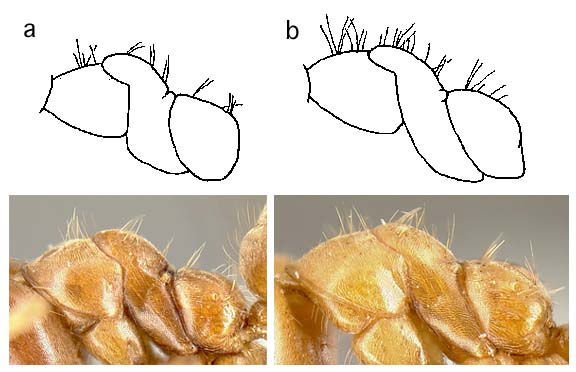
70b. Dorsal face of propodeum devoid of erect setae; SI less than 50; HW of larger workers usually less than 1.0mm; entire mandible generally smooth and shiny on interspaces between puncta: brevis
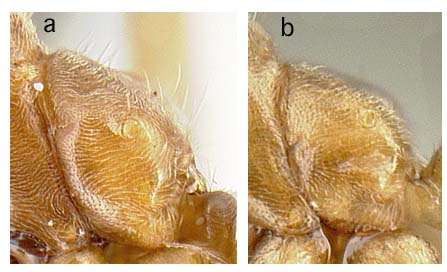
80b. Palpal formula 5,3 or 6,4; color various; dorsal face of propodeum and mesonotum forming two convexities that meet at impressed metanotal groove; nesting habits various: 90
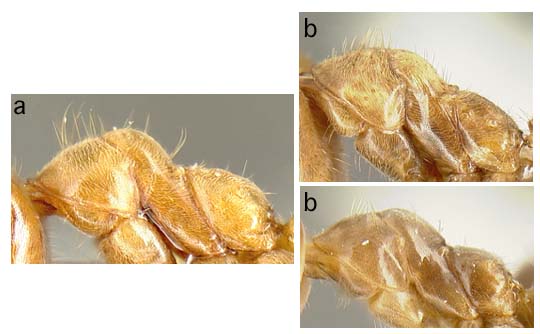
90b. Palpal formula 6,4; species nesting in large plant cavities or ant gardens, with conspicuous and generalized surface foragers: 170
100b. Head relatively narrow, CI less than 90; inhabitants of live stems but not obligate Cecropia specialists: 130
110b. Setae on metatibia abundant and longer, MTSC greater than 20, length of setae one half or more maximum width of tibia; HW of larger workers greater than 1.10mm; obligate inhabitants of Cecropia: 120

120b. Petiole in profile with node less massive than sternal lobe, perpendicular distance from tergosternal suture to apex of node less than distance to ventral margin of sternal lobe; face uniformly brown: constructor

130b. Dorsal surface of mandible with large piligerous puncta, if present, restricted to masticatory margin and apex, mandibles not appearing bristly; nesting habits various, including obligate inhabitants of Cordia and Triplaris: 140

140b. Setae on metatibia more abundant and longer, MTSC 8-17, setae about as long as half width of tibia; dorsal face of propodeum with 4 or more setae, these setae long, greater than 4 times width of propodeal spiracle; largest workers with HW less than 1.0mm: 160

150b. Face of largest workers brown; dorsal surface of mandible with interspaces between puncta shagreened on basal half or more; posterior margin of sternal lobe of petiole with cluster of erect setae of even length; obligate inhabitant of Cordia alliodora: oecocordia

160b. Head relatively narrower (CI 73-81); obligate inhabitant of Triplaris melaenodendron: longiceps

170b. Mandibles shiny to weakly sculptured; largest workers typically smaller, HW less than 1.8mm; nesting habits various (the workers of the following species are highly variable and I have not been able to discover diagnostic characters that always differentiate them; the following key couplets reflect average differences among species, but I have examined many worker series in this complex that I could not place): 180
180b. Gastral dorsum dark brown, or, if light yellow brown, petiole and mesosoma are lighter brown as well, gastral color not sharply contrasting with mesosoma color: 190

190b. Head relatively narrower; scape relatively longer; face color various but often a mixture of light and dark brown; setae on vertex margin usually shorter than eye length; nesting habits various: 200
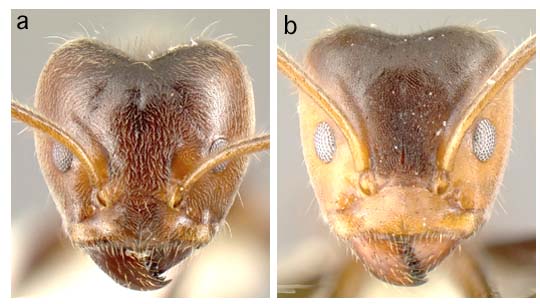
200b. Largest workers with HW usually less than 1.2mm; general coloration often dark brown with light orange brown restricted to anterior and lateral portions of head; head shape often less strongly cordate: 210

210b. Scape relatively longer (SI 84-105); nests in ant gardens: nigra
QUEENS (Costa Rica)
The queen of A. chartifex is unknown, but it will probably key to A. tonduzi.
10b. Outer margin of hind tibia with erect setae reduced to absent, MTSC < 20, if MTSC in the 10-20 range, CI < 80: 110
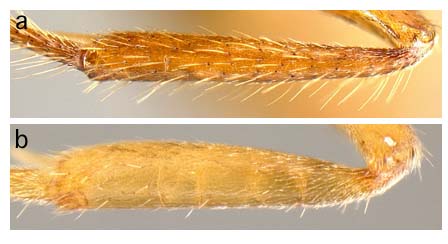
20b. Head with sides more rounded, CI > 90, nesting habits various: 40
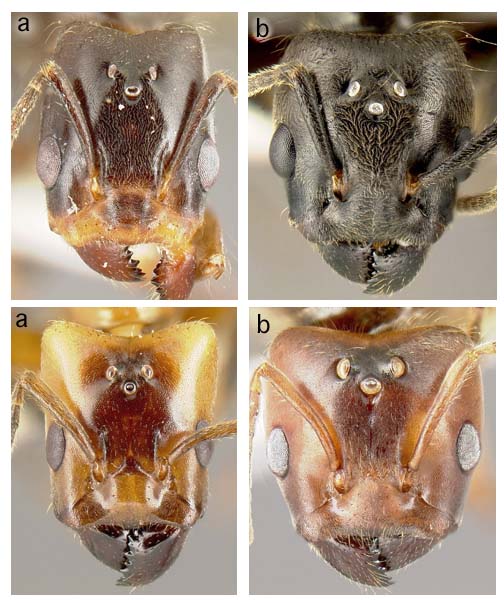
30b. Color orange, HW > 1.80mm; palpal formula 5,3: xanthochroa
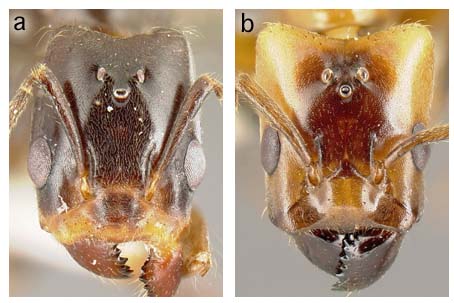
40b. Color rarely solid black, usually red brown, or black with lighter yellow brown on variable extent of anterior and lateral face; mesosomal dorsum often with abundant setae but never a dense brush; setae on margin of vertex shorter than distance between lateral ocelli; HW various; palpal formula 6,4; not obligate Cecropia inhabitants: 50

50b. HW < 2.2mm; face with variable combination of black to lighter yellow brown (varies from almost entirely black with narrow region of lighter color at anterior margin of head capsule, to almost entirely yellow brown with patch of infuscation on posteromedian vertex): 70
60b. Antennae relatively shorter (SI < 55); ocelli small (OCW < 0.15mm); posterior sternal lobe of petiole more convex and shorter, meeting posterior tergal lobe before apex; apex of petiolar node acute but not as strongly flattened, more bluntly rounded: gnava

70b. HW < 1.9mm; face coloration as above or more extensively dark brown to black: 80
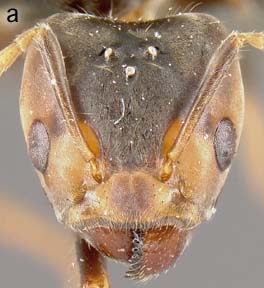
80b. HW > 1.58mm; head coloration as above or with more extensive yellow coloration extending up sides of head and into antennal fossae: 90
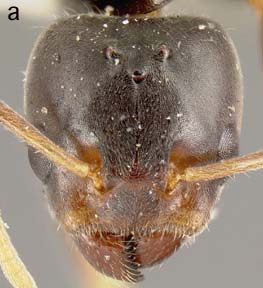
90b. Sternal lobe of petiole evenly curved to tergosternal suture, not forming separate convexity or notch, posterior tergal lobe extending further posteriorly than sternal lobe; head relatively longer (measurements: HW x HLA, velox, quadraticeps); nests in live or dead stems with variable construction of small carton shelters, but not forming large conspicuous ant gardens: 100
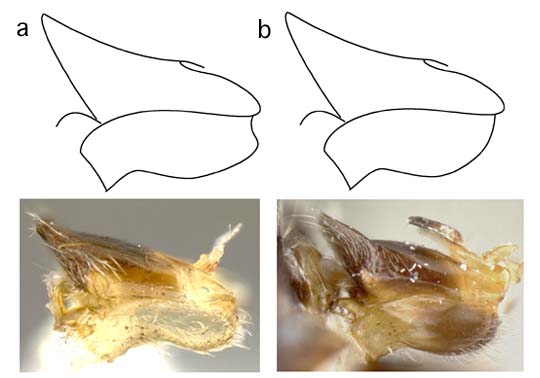
100b. Head relatively longer and more quadrate, sides less strongly narrowing anteriorly: quadraticeps

110b. Meso- and metatibia with distinct pectinate spurs; anterior margin of clypeus weakly convex, subparallel with lateral lobes (HLB/HLA <1.01); body surface duller, not shiny: 140

120b. Color brown; posterolateral margins of vertex not forming pronounced triangular lobes; CI < 80: 130

130b. HW > 1.00mm; sides of head subparallel, not converging toward posterolateral lobes of vertex; outer surface of metatibia with pubescence relatively short, sparse, appressed, and inconspicuous; outer surface of metatibia lacking erect setae or with a few, irregularly spaced, short setae near the base: schimperi
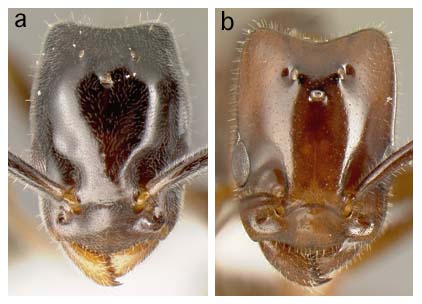
140b. Head relatively long and narrow, subrectangular (CI < 78): 180

150b. Petiolar node not strongly flattened, apex usually bluntly rounded; head relatively longer and thinner (CI < 90): 160

160b. HW < 1.45; much of dorsal surface of mandible with sparse, small puncta bearing setae that are reduced to short remnants, no longer than width of puncta, puncta with longer setae restricted to apex and near masticatory margin; Cecropia specialists: 170

170b. Fourth abdominal tergum with > 10 erect setae (rarely fewer), exclusive of posterior row; dorsal surface of head, when viewed in profile, often with setae bridging the gap between the ocellar region and the upper vertex, and often with setae extending up from the clypeus almost to the ocellar region; scape relatively longer (SI 49-54); color black to lighter red brown: ovaticeps
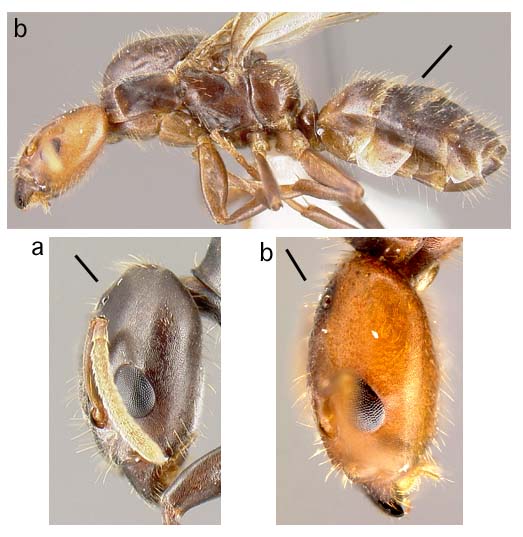
180b. Color largely or entirely black; HW < 1.2mm: 190

190b. Mandible with row of piligerous puncta along masticatory margin, but large puncta sparse to absent on mandible surface proximal to this row, and with at most four puncta bearing setae: 210

200b. Scape longer (SI 50-52): nigricans

210b. Head less rectangular, with sides slightly convex, and lateral margin of vertex more broadly rounded; head relatively shorter and wider (CI > 63): pittieri
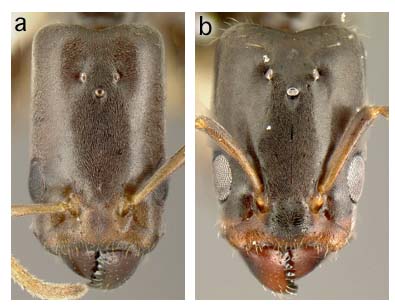
220b. Petiolar node higher, anterior face somewhat concave; metatibia with relatively more setae (MTSC 10-20); propodeum with setae sparse or abundant; mandible with about 5 large puncta proximal to masticatory margin; size relatively smaller (HW < 0.93mm): longiceps

Page author:
John T. Longino, The Evergreen State College, Olympia WA 98505 USA.longinoj@evergreen.edu